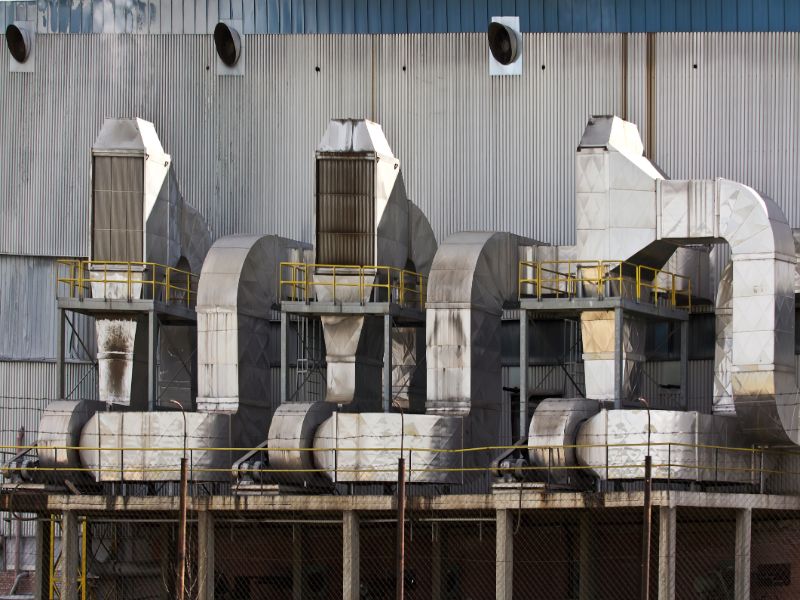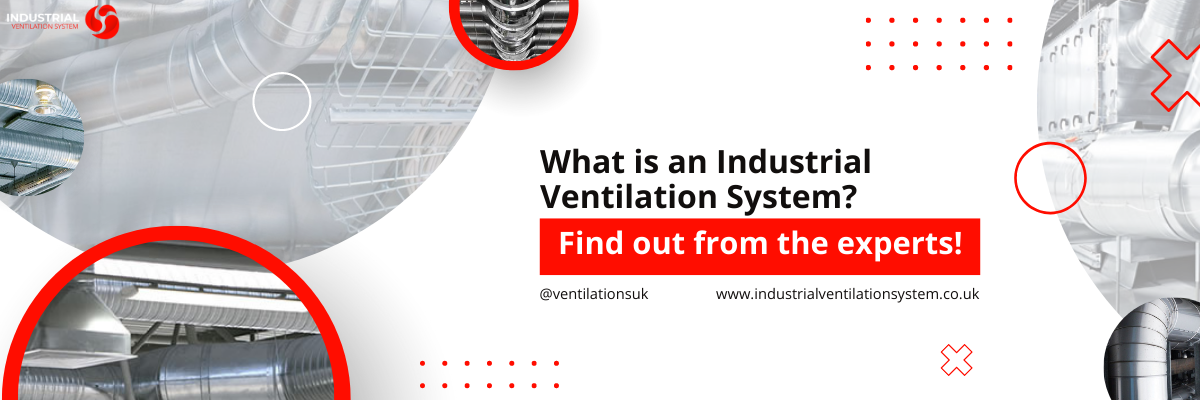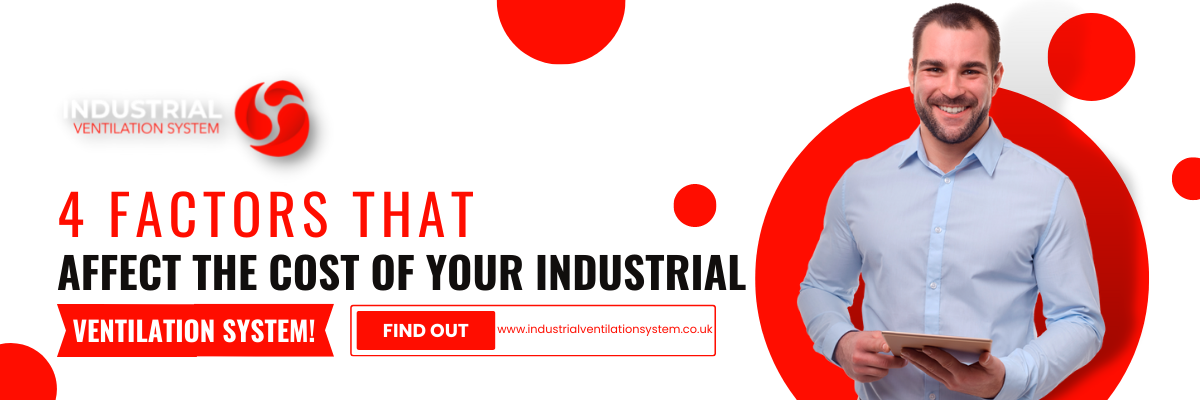20+ Years Experience
Specialist Industrial Ventilation Systems

An industrial ventilation system can be a key part of any industrial building, allowing for proper air movements and the management of dust control in areas that need to stay breathable.
Here at Industrial Ventilation System, we are expert ventilation system installers who have installed thousands of ventilation systems across the UK.
With installers based nationwide, we can offer competitive prices and in December 2025 are able to get quotes to you very quickly.
Each of these systems has two main parts: one that is meant to keep fresh air flowing, and another that gets rid of any contaminants that could be a threat to the health of employees and workers.
However, if you do not already have an industrial ventilation system (or need an updated exhaust ventilation system to deal with air contaminants), then it is not always clear how they work or what they are for.
We offer a number of great Industrial Ventilation System services in Barking and are more than happy in assisting you on anything from price, to dimensions, to specification.
All enclosed buildings need ventilation solutions in one way or another, and that is not always possible through a normal commercial ventilation design.
Not only is air conditioning needed on a much larger scale, but industrial operations can produce a lot more contaminated air and other hazards, most of which are going to be a problem for a worker to deal with.
The exact industries involved can change the kind of threats that end up in the air, but most of the time, they are things that can’t simply be ignored.

Whether it is carbon dioxide, particles from automated wood-cutting gear or fumes from noxious chemicals, it is very hard to create safe “breathing zones” without improved ventilation systems.
Not only is it a health risk, but it can sometimes cause problems with the industrial gear being used, too.
Industrial ventilation systems are generally any ventilation system that has been scaled up for industrial use and checked to make sure that it keeps employees safe and there is good air quality.
In short, they are ventilation systems that can be safely used in industrial settings, filtering out hazards and allowing a fresh airflow that keeps the air inside breathable.
The more severe the hazards and bad conditions are, the more important it becomes to keep workers’ environments safe for them since a lot of industrial processes can create very dangerous waste products.
We manufacture and install a range of industrial ventilation systems, and our expert team of professionals offer insights and provides top-notch installation services.
We offer the highest quality standards, and all our installations come with an optimal guarantee which gives you the best aftercare customer service.
At Industrial Ventilation System, we can assist you with the best specifications, costs and prices.
Make sure you contact us today for a number of great industrial ventilation systems.
The biggest difference between normal and industrial ventilation systems is the size of the ventilation gear installed in the working environment.
Pipes and vents are often much larger, sometimes even human-sized, and the various appliances or devices connected to the system operate at a higher level.
The end goal is to pump fresh air into a larger space at a faster rate while also making sure that indoor air quality remains safe and breathable.
They often combine multiple different types of air conditioning systems and air movement options to make sure that the working environment is safe.
As of December 2025, there are two major types of industrial ventilation systems that most people will encounter, although each one can come in a number of different designs and won’t necessarily look identical to another system of the same type.
These are local exhaust ventilation systems and dilution ventilation systems.
Both versions are meant to solve the same problems: poor air quality, a lack of breathable air, working environments that are unsafe for workers, and dangerous contaminants not being removed from the room.
The cleaner the indoor environments are, the lower the health risk to workers around industrial machines.
Local exhaust ventilation systems are designed to target whatever is creating contaminated air, removing the air contaminants before they can pose any real threat to industrial workers or other employees in the work area.
With local exhaust ventilation, the system takes the air that contains the contaminant material and uses an exhaust fan or similar tool to vent it outside, where it disperses into the outdoor fresh air rather than being contained in a single indoor space.
In theory, this means that the ventilation system can maintain high indoor air quality by sucking out any bad air, meaning that the working environment only gets fresh outside air coming from another air intake system.
This is generally the easiest way to manage any chemicals that create a fume or gas when handled, keeping productivity stable by managing to exhaust air (and the contaminants inside it) straight away.
Dilution ventilation systems do not directly dump the bad air outside. Instead, they improve indoor air quality by piping in the new fresh outside air, diluting the indoor air so that the contaminants (such as dust) are not actually as prominent.
This basically means that the ventilation equipment is forcing the room to hold more air, which leaves less ‘space’ for the contaminating material.
These systems work best when the outside air quality is higher than the indoor air quality: if it is not, then the ventilation system will pump unsafe air into the building.
This means that industrial buildings in very contaminated areas or around other buildings that use an exhaust system may have to use an exhaust system too since dilution won’t be as effective.
If you would like to receive even more information on Industrial Ventilation System services in Barking, make sure you get in touch with us today!
At a basic level, an industrial ventilation system is a common sense.
Keeping an environment clean through good ventilation technology leads to improved productivity, makes the workplace safer and prevents a build-up of things that could cause equipment faults (like smoke getting into air purifiers or flammable gas reaching open flames).
The better the dilution or exhaust system, the easier it becomes to keep the air clean and breathable.
The more breathable the air is, the safer your employees are.
Not only is poor air a clear sign of negligence on the building owner’s part, but not having a good ventilation system can make it much harder to be sure that all employees are actually safe.
While it can be cost-effective to remove an industrial ventilation system from a working environment and have workers wear protective gear (like dust masks), a slow build-up of contaminants can lead to poisoning, nausea, temporary blindness, inability to breathe, fainting, and even death depending on what is actually filling the room.
There have been multiple cases where a business has refused to use the proper ventilation system and ended up with multiple dead employees.
Many of these are the result of something as simple as a fire or a machine that produces CO2 as a waste product since no exhaust fan means that it won’t always leave the facility.
Even with other safety gear in place, it can become very hard to stop a fire or mechanical fault when smoke is filling the room, and there is no ventilation to remove it.
Keeping each employee safe is a major upside and something that all companies should keep focused on, but there can also be other improvements involved.
Air quality does not just impact employees: in a workplace with multiple pieces of related equipment, it can also put products in danger or even the equipment itself.
A working environment full of flammable gas will become much more likely to burst into flame or explode if a blowtorch is used, and even if nobody dies or suffers injuries, that can leave hundreds of machines needing to be repaired or replaced.
On top of that, a workplace that is full of contaminants can damage particular products.
For example, a factory that creates glass bottles meant for holding drinks may have to decontaminate every product if they can’t vent the contaminants out since each bottle could contain poisonous or nausea-inducing dust.
Smoke seeps into most fabrics, which can be another source of trouble in factories that make clothes, soft toys, or other fabric-based products.
Industrial ventilation systems are also ideal for keeping a space consistent. This prevents unexpected temperature changes, visibility issues, unexpected reactions and quality problems with raw materials, or other concerns that you may not notice straight away.
The more indoor environments change, the more problems you might encounter, especially in a facility that relies on certain conditions to produce items.
This can be a major risk in areas that handle a lot of chemicals as raw materials since many chemicals can suffer quality hits or suffer a variety of unwanted changes if they are contaminated or if the ambient temperature swings too far in either direction.
Heating costs may change for the better if the air outside is warm, allowing you to use less energy heating the building.
This can also go in the opposite direction: if the installation is sucking in the cool air on a hot day, you do not need as many fans to cool the space down.
So, by installing fume extraction systems, you can save money on running costs in the work environment. Extraction systems can be the best solution to improve working conditions in an industrial facility.
The design of a good local exhaust or dilution ventilation system (depending on your preferred choice) can enable you to set up extra gear related to the industrial ventilation systems themselves, such as air purification systems or air conditioning/heating options.
However, the system needs to make sure that it does not pump contaminated air from the source into an office or employee kitchen, etc.
Compliance with health and safety standards is always a major plus.
While all companies should follow them anyway, a clear and well-telegraphed ventilation system can make it easier to answer an inspection question related to the vent systems.
If a safety inspector asks a question about your dilution ventilation system, but you can’t actually point out any ventilation systems or tell them where the air supply goes, it can reflect badly on the company management.

Industrial ventilation systems can cost between £300 to £10,000.
The cost will be dependent on a range of factors, including:
To receive accurate, no-obligation quotations from our team of experts, get in touch with us today!
The use of makeup air – air that is used to “make up” whatever has been lost in the working environment – is a necessary part of health and safety.
Ventilation system requirements are often a key part of any health and safety document or inspection, and proper ventilation applications are quite simple: the air inside a facility needs to be breathable and safe 100% of the time, not counting the vents themselves or any rooms designed to handle this impure air.
A makeup air supply is a key part of this, and not just because it makes the internal environments a lot safer for workers.
In many case studies, one of the biggest risks, when it came to indoor environment safety, was contaminants positioning the air: just because air is being pumped in does not mean that it is safe to breathe.
Air quality is the main focus of all industrial ventilation systems. Circulating a contaminated air supply can help with heat transfer problems, but if you are not using local exhaust ventilation or dilution ventilation system to replace the old air with new, fresher air, then there is usually no way for employees to work in that space safely.
Emission sources can be almost any machine in the environment. Anything that will supply dust or other contaminants into the air is something that has to factor into the design since every industry may have a whole range of equipment that causes these problems.
Even a small chemical reaction can result in a process change that creates CO2, and a poor industrial ventilation design may not account for this.
At Industrial Ventilation System, we can assist you with the best specifications, costs and prices. Make sure you contact us today for a number of great Industrial Ventilation System services.
These ventilation system requirements are also usually related to keeping employees aware of the air supply itself.
A local exhaust ventilation installation may need to include signs that warn them of a high air velocity near large fans, for example, while a dilution ventilation system should let them know that contaminants are not removed instantly.
They should be easy to use and understand if possible: this does not mean that the design should give them the choice to close the industrial ventilation system manually, though.
The design criteria behind these industrial ventilation systems will vary. The rules you have to follow may be different from elsewhere, or even the country as a whole.
You may experience some cases where you have to alter part of the design or change where a certain industrial ventilation hood is placed, but this is often because the design does not accurately collect contaminants.
Throughout the UK, industrial ventilation should be used to limit exposure to dust, fume, vapour, mist, and gas. These systems have to draw the dust (etc.) from the source near a worker.
Not only do they need to clear this dust away, but workers need to understand how to use them to pump out excess dust. Ideally, they should always move the dust away from any workers without creating cracks or holes for the dust to leak back out.
The “hoods” used on these industrial ventilation systems need to be placed near any installation that will be a source of contamination, and somebody must service them regularly.
Part of the service process includes checking to see if the industrial ventilation is still running properly: if a service attempt finds out that a dilution ventilation system is not drawing in any more air from the outside source, for example, then it will have to be repaired as soon as possible.
Most health and safety experts agree that the application of industrial ventilation systems is a good thing, but this installation has to be done correctly.
There is not a single perfect way to handle industrial ventilation installation since each building may have different industrial ventilation needs based on its design or the design of the machines it contains.
If you are looking for a good ventilation system design that can provide a safe working experience, then let us know if there is anything specific you need.
Whether it is by email or through another contact method, one of the best ways to get help with ventilation is to ask.
Every building is different, and every work experience may require specific tweaks to the standard ventilation system formula, so a simple email and name can be enough to get you in contact with an expert!
Ventilation is an essential part of any industrial environment, and nobody wants their name to be listed as responsible for a poor installation job.
Even if you work in an industry that does not carry a lot of dangerous chemicals, it is very important to make sure that fresh air is available and properly managed, especially when dealing with workspaces that contain a lot of workers and not a lot of easy access to air if a machine starts belching out smoke.
How you approach your ventilation system based on your building design is up to you since individual machines may be less polluting or contaminating than others.
It all depends on what would be best for your employees and the various materials or machines that you run.
Make sure you contact us today for a number of great Industrial Ventilation System services.
We absolutely love the service provided. Their approach is really friendly but professional. We went out to five different companies and found Industrial Ventilation System to be value for money and their service was by far the best. Thank you for your really awesome work, we will definitely be returning!
Ollie DayWe have used Industrial Ventilation System for many years as they are certainly the best in the UK. The attention to detail and professional setup is what makes this company our go-to company for all our work. I highly recommend the team for the immense work - we highly recommend them!
Nathan RyanFor more information on Industrial Ventilation System services in Barking, fill in the contact form below to receive a free quote today.
We Aim To Reply To All Enquiries With-in 24-Hours